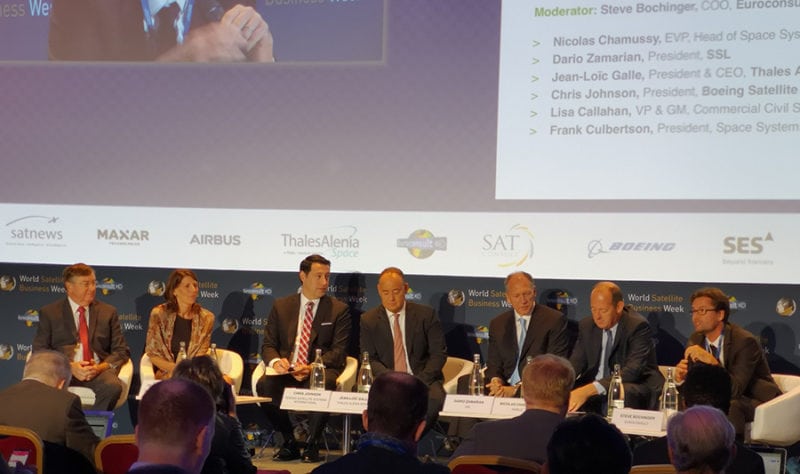Latest News

The Manufacturer’s Panel at World Satellite Business Week 2018
Executive leaders from the world’s largest satellite manufacturing companies believe that software-defined satellites are the future of an industry that is seeing a majority of its customers transition away from GEO-focused business models.
Speaking at a session titled ‘Manufacturing: Shifting Towards A More Software-Defined World’ at World Satellite Business Week (WSBW), senior executives from all the top satellite manufacturers tried to come to terms with new market dynamics. Jean-Loic Galle, President and CEO of Thales Alenia Space said, “Our customers are getting more demanding. There is more competition from terrestrial technologies. There is an uncertainty about the market. In terms of the market, software defined solutions are absolutely key. We are focusing around software technologies. We are working on the processors. We have developed some very powerful processors to drive antennas.”
When asked about future trends in the satellite manufacturing arena, Galle said he sees the main trend going towards towards mid-sized, totally flexible satellites. “There is uncertainty about the applications that the operators will use to drive this. Operators don’t know what the most promising market will be in three-to-five years’ time (for bandwidth). There will also be cases where customers want to target a specific market and confident that market will exist for a few years.”
Chris Johnson, President of Boeing Satellite Systems admitted that while it was important to make progress in terms of digital processors, innovation should be thought about in terms of how its drives cost-effectiveness.“We can add more flexibility within the spacecraft. The satellite that could go from band to band is the panacea,” he said. “We need to get capability to market quicker. On standardization, there is a lot of work to do. We talk in numbers of satellites. While we are feeling some of those numbers in GEO will decline, we are taking steps to address those other aspects of the market. There will be less GEO satellites (going forward).”
Nicholas Chamussy, EVP and Head of Space Systems for Airbus said that when it comes to innovation, the first thing his company is focusing on are software-defined satellites. He said Airbus has more than 15 satellites with software defined payloads either in orbit and getting ready to launch. In terms of electric propulsion, he said Airbus has 10 either flying or in development. Interestingly, Chamussy said it was not beyond the realms of possibility we could see 15-18 GEO satellites ordered in the future per year, which was definitely one of the most optimistic forecasts, especially as others like Gwynne Shotwell of SpaceX said they believe the market for GEO satellites could now be in a permanent decline.
Lisa Callahan, VP & GM, Commercial Civil Space, Lockheed Martin Space Systems said even despite the tough market conditions, this is a really exciting time to be in space. “We need to define things with software. I think software defined satellites and ground systems are the future. That has been a big emphasis of ours. We are seeing a lower number of GEO satellites in the commercial world. This year, we have announced we are investing another $100 million into our ventures business. So, $200 million a year. We see partnerships as a key enabler. There are 975 new start-ups in the space industry. That investment in new technologies is key,” she said.
One of the strong performers in the manufacturing sector over the years has been Maxar’s SSL satellite company. There is a strong possibility it could look to exit the GEO market at some stage, according to SSL President Dario Zamarian, who like others, admitted that the number of GEO communications satellite orders has dropped dramatically, with this year shaping up to be no better. Zamarian thinks that while there will be sufficient video business and a replacement market, it is not obvious that SSL’s customers have found a magic formula for what happens next. Zamarian said SSL was thinking carefully on what it should do next in terms of GEO, and hinted at either a partnership or selling this part of the business. “The market is changing. We continue to pursue business. The market needs to be re-energized. Demand is there. We haven’t found the right formula there,” he said.
On the technology side, Zamarian said manufacturers need to start thinking about optical payloads and about making satellites simpler to operate in space. “There are a number of technologies, including robotics, that will be at the center of this revolution. We are working on standardization, because we believe a better supply chain helps. We are working on digital payloads,” he said. “We are working on robotics. We want more homogeneous integration with 5G networks. Robotics and on-board servicing and on-board assembly will be a major way to do things quite differently going forward.”
Get the latest Via Satellite news!
Subscribe Now